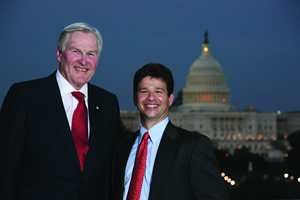Mr. Friendly Goes to Washington

While equally passionate about his topic, Ian Friendly faced a far more receptive audience when he accepted an invitation from Michael Wilson, Canadian Ambassador to the U.S., to lend his support by extolling the benefits of free trade between the two countries. The QSB Advisory Board member and proud Commerce'83 grad is the Executive Vice President and COO of General Mills Inc., in charge of their U.S. Retail business. More than 140 dinner guests – American leaders in business and trade associations, along with the 13 Canadian Consuls General in Washington – gathered to take in Ian’s remarks at the second All Politics is Local (APIL) event in June.
The brainchild of Ambassador Wilson, APIL is a direct response to the perceived growing wave of protectionism among U.S. political leaders and their constituents. “Not all Americans are convinced of the benefits of international trade,” Ambassador Wilson told his guests. He’s working to debunk those perceptions with a national campaign featuring messages from the 13 Consuls General and real-world proof that the supply chain across the border unites and benefits both Canada and the United States.
 Michael Wilson, Canadian Ambassador to the U.S., and Ian Friendly“It’s exactly the kind of story we should also be telling in Canada,” says Ian, since 60% feel the country has been the loser in NAFTA. He spoke to QSB Magazine from his Minneapolis office, where he oversees General Mills’ Big G, Yoplait, Meals, Pillsbury U.S., Snack and Baking Products Division. The recent economic crisis has only added fuel to his fire.
Michael Wilson, Canadian Ambassador to the U.S., and Ian Friendly“It’s exactly the kind of story we should also be telling in Canada,” says Ian, since 60% feel the country has been the loser in NAFTA. He spoke to QSB Magazine from his Minneapolis office, where he oversees General Mills’ Big G, Yoplait, Meals, Pillsbury U.S., Snack and Baking Products Division. The recent economic crisis has only added fuel to his fire.
“The knee-jerk tendency in tough times is to lean toward protectionism, but when times are tough, barriers will only make things worse.”
Why? Ian tells General Mills’ free trade success story in the following edited version of his June 2008 address to the All Politics is Local event.
Mr. Ambassador, I want to thank you and the Embassy staff for your creativity and hard work in establishing the All Politics is Local program. It’s a special honour for me to be here with you, because the issues you’ve been discussing on the Hill are not theoretical or abstractions for me. They are so much a part of my everyday life that I’m kind of a living, breathing free trade zone.
I was born and raised in Ottawa, and my extended family – parents, brothers and cousins – still live there. After graduating from Queen’s University in Kingston, Ontario, in 1983, I started to work for General Mills in Toronto, but then came down to the proverbial south, crossing the border to live and work in Minneapolis, which is my home today. I use “proverbial” as Minneapolis is actually north of Toronto, a fact I wasn’t quite aware of when I was offered the opportunity to move.
For me, the close connections between the United States and Canada in so many areas – from economics to culture – have meant opportunities . . . opportunities that have made my life remarkably better. And what has been true for my family has also been true for Americans and Canadians as a whole.
Take a look at employment, which is so important to national well-being. Since NAFTA strengthened the economic connections across the border, Canada has enjoyed steady gains, with employment going up from 14.9 million to 18.1 million in the 2000s. And two-way trade has more than tripled since the original Canada-U.S. free trade agreement.
...Trade Is Overwhelmingly A Positive Sum Game - Where Both Parties, All Parties... Benefit.
It’s not just U.S.-Canada trade, of course. International trade as a whole has proved to be a remarkable economic powerhouse for everyone.
- Consider that, here in the United States, 31million American jobs (nearly 1 in 5) are now linked to exports and imports of goods and services. That’s up from 14 million jobs in 1992, before a string of agreements liberalized trade.
- In the past decade, American exports produced by American workers accounted for one-quarter of U.S. economic growth.
- And at a time of terrible news in housing and financial services, American exports are growing – 9.5 percent over the past four quarters. Those exports have helped keep the U.S. economy afloat.
And global trade is an inclusive economic engine. It helps the world’s poorest people, lifting hundreds of millions out of poverty through the creation of better jobs, improved living standards and increased opportunity. In less than 25 years, for example, 230 million people have been lifted out of poverty in China thanks to international trade. Economists consider that one of the greatest achievements in fighting poverty in history. Thanks in large part to international trade, India’s per capita income has almost tripled, and its middle class has quadrupled to more than 250 million people.
Looking ahead, the World Bank estimates that eliminating trade barriers will pump at least $300 billion into the world economy in just the next 10 years. That will help ensure that poverty will no longer be a chronic disease for more than 300 million people.
Now I know that many of the facts I’ve just mentioned are not news to this audience. In fact, many of you could probably recite them in your sleep. But as impressive as these facts may be, they are also frustrating. Why? Because they just aren’t registering with the North American public. Perception and reality, I think, are two different things.
Despite all the clear evidence to the contrary,more Americans believe international trade slows the economy than grows it. Forty-four percent say it lowers wages, too. Barely more than a third say trade has helped them or their families. And yet, despite the less-than-sanguine perception that America doesn’t produce anything anymore, America remains a world leader when it comes to exporting goods and services. Last year, the United States exported more than a trillion dollars of goods alone.
In Canada, I fear the perception is even worse: 60 percent of the people feel the country has been the loser in NAFTA, and only 30 percent believe that Canada has been the winner. I find those numbers so interesting because they show one of the reasons why critics of trade seem to have the upper hand: They’ve succeeded in portraying international trade as a zero sum game. If one country benefits, it is the winner and the other trade partner “must” therefore be the loser.
That view explains, I think, why some candidates for president expressed skepticism about international trade in general and NAFTA in particular.
What can be so frustrating at times is that the truth is that trade is overwhelmingly a positive sum game – where both parties, all parties, to a trade agreement benefit.
How can we get the hidden truth out? In my view, the APIL approach is exactly right: Tell true-life stories.
I’m a business executive, as are a lot of you out there. One thing I know about business people is that we love statistics almost as much as Canadians love hockey. Statistics tell us how much we’re selling, how efficient we are,where our stock price is,how we’re doing compared to our competitors. Unfortunately, when it comes to changing public opinion and swaying legislators, stories trump statistics almost every time. You can’t beat a story of the real effects of trade on real people and companies.
I’d like to share one story, a General Mills story, with you. I want to share the story of why the wholly integrated Canada-U.S. supply chain is absolutely vital to our mission.
Let me get the statistics out of the way first. We’re the world’s sixth largest food company. We market in more than 100 countries on six continents, and our 28,000 employees generate more than $13.4 billion in annual revenues and more than $1.1 billion in profit. I won’t even try to name all of our brands and products, except to say I can almost guarantee you have consumed one of them in the last 24 hours. Our mission as a company is “Nourishing Lives” – innovating to make people’s lives healthier, easier and richer.
To tell the story of why the integrated cross-border supply chain is so pivotally important to that mission, I have to start by talking about breakfast. It’s a safe bet a lot of the people in this room, or your kids, had Cheerios for breakfast – the first ready-to-eat oat cereal and the number-one breakfast cereal in the world. Did you ever wonder how those delicious crunchy round things got to your bowl?
Well, they start as oats in Canada. In fact, we buy a whole lot of Canadian oats; some 6,000 railcars of our oats come south every year. If you put all those cars on one train, it would stretch more than 67 miles. Step two, we process those oats in the United States,mainly in Minnesota. And a lot of those oats are made into Cheerios. Step three, we ship those Cheerios to distribution centers and then to stores, where they make their way into your cereal bowls. Some of those Cheerios go into Canada–where they started out as oats. The rest are sold in the United States.
In short, the story of the number-one breakfast cereal in the world is the story of a supply chain that is completely integrated across the border. We count on it. We depend on it. We can’t serve our customers without it.
And I could tell pretty much the same story for many of our other products, where the basic material and finished products cross back and forth between the two countries.
At General Mills, we know we can count on a Canada-U.S. supply chain that is secure, efficient, and seamless. It’s been that way for more than a decade, ever since international trade agreements eliminated virtually all tariffs on our key products, along with most other non-tariff restrictions. As you can imagine, we don’t want to see that situation change.
To be sure, no system is perfect, and even the best of friends have disagreements. There are some trade issues between our two countries that we would like to see resolved. Given the level of trust that has developed over the years and the benefits to everyone of the integrated supply chain, I’m confident they can be worked out.
Above all, we don’t want to go back to the bad old days before NAFTA and the U.S.-Canada free trade agreement, when the supply chain was snagged by tariffs and licensing agreements. As a company, we don’t have to look too far to see how difficult things can be. In Colombia, for example, our products – many of the same ones we sell in Canada – face tariffs of up to 20 percent. Colombian consumers pay the price. And, in truth, we all pay a price, for that loss in trade will create fewer job and economic benefits here at home. Let me reiterate that free trade is a “rising tide that raises all ships”…a positive sum game.
Let me close by thanking you again for inviting me and for making the case for trade on Capitol Hill. If we all keep telling our stories, the public and political leaders will finally see how trade can boost innovation, push people’s incomes higher and make lives better and more rewarding.
